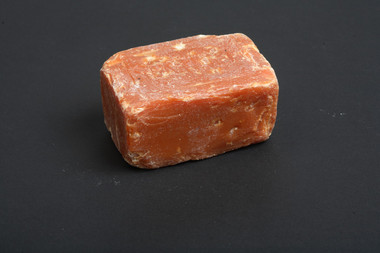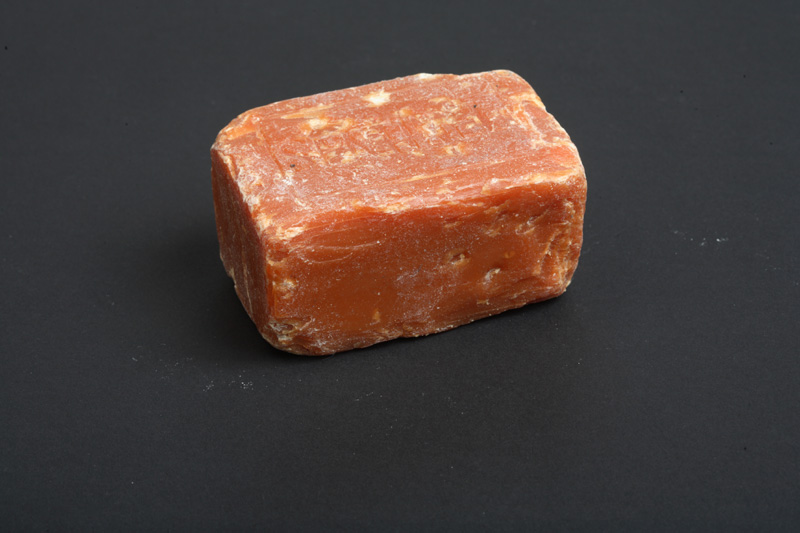Carbolic Soap, Victorian
This piece of soap dates probably dates from the 1940s, but would have been a staple item in many homes, schools and hospitals from Victorian times until the mid 20th century. In some parts of the world it is still used.
A block of carbolic soap was an essential item in every household, rich or poor. This rough soap containing the disinfectant phenol or carbolic acid was bought at the ‘oil shop’ – rather like today’s hardware store. It was bought in chunks cut off a huge green or orange block and wrapped in newspaper. Other items for sale would have been such things as paraffin for oil lamps, and other cleaning materials such as soda in penny lumps.
Carbolic soap was used for everything from personal hygiene to household uses. It was used for the weekly full body wash in the tin bathtub, for hair washing and, along with a damp cloth, just to wash face and hands in a basin in the bedroom on a daily basis. It was also used for such household chores as washing clothes and cleaning out the chamber pots in the morning.
A whole variety of other substances would have been used around the house. Baking soda was used with water for cleaning dishes. Vinegar and salt was used to clean brass and copper. Vinegar was also used to clean windows. Eggshells and lemon were mixed together and would act as a powerful scouring agent for dirty pots and pans. Even stale urine was used as a degreaser for heavy materials such as wool.
Today some of those old fashioned cleaning methods have become popular again since we have become conscious of the damage commercial cleaning products can cause to our health and environment.
A block of carbolic soap was an essential item in every household, rich or poor. This rough soap containing the disinfectant phenol or carbolic acid was bought at the ‘oil shop’ – rather like today’s hardware store. It was bought in chunks cut off a huge green or orange block and wrapped in newspaper. Other items for sale would have been such things as paraffin for oil lamps, and other cleaning materials such as soda in penny lumps.
Carbolic soap was used for everything from personal hygiene to household uses. It was used for the weekly full body wash in the tin bathtub, for hair washing and, along with a damp cloth, just to wash face and hands in a basin in the bedroom on a daily basis. It was also used for such household chores as washing clothes and cleaning out the chamber pots in the morning.
A whole variety of other substances would have been used around the house. Baking soda was used with water for cleaning dishes. Vinegar and salt was used to clean brass and copper. Vinegar was also used to clean windows. Eggshells and lemon were mixed together and would act as a powerful scouring agent for dirty pots and pans. Even stale urine was used as a degreaser for heavy materials such as wool.
Today some of those old fashioned cleaning methods have become popular again since we have become conscious of the damage commercial cleaning products can cause to our health and environment.

Width:5cm Depth:4cm

Width:5cm Depth:4cm

This piece of soap dates probably dates from the 1940s, but would have been a staple item in many homes, schools and hospitals from Victorian times until the mid 20th century. In some parts of the world it is still used.
A block of carbolic soap was an essential item in every household, rich or poor. This rough soap containing the disinfectant phenol or carbolic acid was bought at the ‘oil shop’ – rather like today’s hardware store. It was bought in chunks cut off a huge green or orange block and wrapped in newspaper. Other items for sale would have been such things as paraffin for oil lamps, and other cleaning materials such as soda in penny lumps.
Carbolic soap was used for everything from personal hygiene to household uses. It was used for the weekly full body wash in the tin bathtub, for hair washing and, along with a damp cloth, just to wash face and hands in a basin in the bedroom on a daily basis. It was also used for such household chores as washing clothes and cleaning out the chamber pots in the morning.
A whole variety of other substances would have been used around the house. Baking soda was used with water for cleaning dishes. Vinegar and salt was used to clean brass and copper. Vinegar was also used to clean windows. Eggshells and lemon were mixed together and would act as a powerful scouring agent for dirty pots and pans. Even stale urine was used as a degreaser for heavy materials such as wool.
Today some of those old fashioned cleaning methods have become popular again since we have become conscious of the damage commercial cleaning products can cause to our health and environment.
A block of carbolic soap was an essential item in every household, rich or poor. This rough soap containing the disinfectant phenol or carbolic acid was bought at the ‘oil shop’ – rather like today’s hardware store. It was bought in chunks cut off a huge green or orange block and wrapped in newspaper. Other items for sale would have been such things as paraffin for oil lamps, and other cleaning materials such as soda in penny lumps.
Carbolic soap was used for everything from personal hygiene to household uses. It was used for the weekly full body wash in the tin bathtub, for hair washing and, along with a damp cloth, just to wash face and hands in a basin in the bedroom on a daily basis. It was also used for such household chores as washing clothes and cleaning out the chamber pots in the morning.
A whole variety of other substances would have been used around the house. Baking soda was used with water for cleaning dishes. Vinegar and salt was used to clean brass and copper. Vinegar was also used to clean windows. Eggshells and lemon were mixed together and would act as a powerful scouring agent for dirty pots and pans. Even stale urine was used as a degreaser for heavy materials such as wool.
Today some of those old fashioned cleaning methods have become popular again since we have become conscious of the damage commercial cleaning products can cause to our health and environment.




















